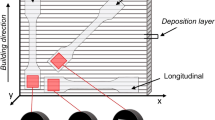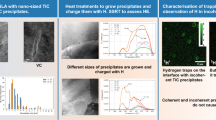Abstract
A review of relevant welding literature as well as ongoing research at the University of Illinois at Chicago indicate the important influences of manganese and oxygen on the weld metal microstructure of low carbon steel welds. These microstructures are composed of several distinct ferrite morphologies, bainite, and other microconstituents. Both manganese and oxygen affect the transformation behavior of the weld metal as it cools from the austenitic range. A high oxygen content, in the form of oxide inclusions, shifts the transformation curve to the left by increasing the number of effective nucleation sites for high temperature transformation products (proeutectoid and side-plate ferrite). Manganese, on the other hand, shifts the transformation curve to the right, thereby increasing the weld metal hardenability and promoting the formation of lower temperature transformation products (acicular ferrite, bainite). Welds with a high proportion of acicular ferrite possess superior fracture toughness because the short, interlocking needles resist crack propagation.
The submerged-arc and gas metal-arc welding processes were both used to make high and low heat input welds with two different levels of manganese (1.0 and 1.6%). Photomicrographs taken with the light microscope along with microhardness measurements were used to distinguish the ferrite morphologies and other constituents present in the weld metal. Quantitative metallography performed on all samples confirmed an increased proportion of acicular ferrite at the higher manganese level. Grain size measurements of the prior austenite also indicated that manganese refines the secondary microstructure.
Submerged-arc welds with oxygen contents from 170 to 1400 ppm were also made. Area fraction measurements show an increase in acicular ferrite as the oxygen level is reduced from 1400 to 400 ppm. However, below an oxygen level of 250 ppm, further reductions in the oxygen content reduce the amount of acicular ferrite as bainite formation increases.
Similar content being viewed by others
References
R.A. Kubli and W.B. Sharav, Advancement in submerged-arc welding of high-impact steels,Welding Journal, 1961, vol. 40: pp. 479s-507s.
A.P. Bennet and P.J. Stanley, Fluxes for the submerged welding of Q. T. 35 steel,British Welding Journal, 1966, vol. 13: pp. 59–66.
W.J. Lewis, G.E. Faulkner, D.C. Martin, and P.J. Rieppel, Submerged arc welding HY-80 steel,Welding Journal, 1960, vol. 39: pp. 266s-272s.
W.J. Lewis, G.E. Faulkner, and P.J. Rieppel, Flux and fiber wire developments, for submerged-arc welding HY-80 steel,Welding Journal, 1961, vol. 40: pp. 337s-345s.
T.H. North, H.B. Bell, A. Koukabi, and I. Craig, Notch toughness of low oxygen content submerged-arc deposits,Welding Journal, 1979, vol. 58: pp. 343s-354s.
J.E. Indacochea and D.L. Olson, Relationship of weld metal microstructure and penetration to weld metal oxygen content,Journal of Materials for Energy Systems, 1983, vol. 5: pp. 139–148.
T.H. North, H.B. Bell, A. Norwicki, and I. Craig, Slag/ metal interaction, oxygen, and toughness in submerged-arc welding,Welding Journal, 1978, vol. 57: pp. 63s-75s.
A.G. Glover, J.T. McGrath, M.J. Tinkler, and G.C. Weatherly, The influence of cooling rate and composition on weld metal microstructure in C-Mn and HSLA steel,Welding Journal, 1977, vol. 56: pp. 267s-273s.
D.J. Abson, R.E. Dolby, and P.H.M. Hart, The role of non-metallic inclusions in ferrite nucleation in carbon steel weld metals, Proc. Intl. Conf. of Trends in Steels and Consumables for Welding, London, The Welding Institute, 1978, p. 75.
R.C. Cochrane and P.R. Kirkwood, The effect of oxygen on weld metal microstructure, Proc. Intl. Conf. on Trends in Steels and Consumables for Welding, London, the Welding Institute, 1978, pp. 103–121.
J.G. Garland and P.R. Kirkwood, A reappraisal of the relationship between flux basicity and mechanical properties in submerged-arc welding,Welding and Metal Fabrication, 1976, vol. 44: pp. 217–224.
R.A. Farrar and M.N. Watson, Effect of oxygen and manganese on submerged arc weld metal microstructure,Metal Construction, 1979, vol. 11: pp. 285–286.
G.M. Evans, Effect of manganese on the microstructure and properties of all-weld-metal deposits,Welding Journal, 1980, vol. 59: pp. 67s-75s.
C.L. Choi and D.C. Hill, A study of microstructural progression in as-deposited weld metal,Welding Journal, 1978, vol. 57: pp. 232s-236s.
R.A. Farrar, S.S. Tuliani, and S.R. Norman, Relationship between fracture toughness and microstructure of mild steel submerged arc weld metal,Welding and Metal Fabrication, 1974, vol. 42: 68–73.
L.G. Taylor and R.A. Farrar, Metallurgical aspects of the mechanical properties of submerged-arc weld-metal,Welding and Metal Fabrication, 1975, vol. 43: pp. 305–310.
R.C. Cochrane, Weld Metal Microstructures—A State-of-the-Art Review, IIW Doc. 11-A-580-83, 1983.
P.F. Chaveriat, G.S. Kim, and J.E. Indacochea, Research in progress, 1985.
D.J. Widgery, Deoxidation practice for mild steel weld metal,Welding Journal, 1976, vol. 55: pp. 57s-68s.
S. Shah and J.E. Indacochea, Effects of inclusion morphology and size on the microstructure and toughness of HSLA steel welds, Engineering Foundation sponsored research, 1985.
T.G. Davey and D.J. Widgery, A Technique for the Characterization of Weld Metals Microstructures, IIW Doc. II-A4-389-76, 1976.
R.D. Thomas, Submerged-arc Welding of HSLA Steels for Low Temperature Service,Metal Progress, 1977, vol. 111: pp. 30–36.
D.J. Abson and R.E. Dolby, A scheme for the quantitative description of ferritic weld metal microstructures,The Welding Institute Research Bulletin, 1980, vol. 21: pp. 100–103.
E. Levine and D.C. Hill, Structure/property relationships in low C weld metal,Metallurgical Transaction, 1977, vol. 8A: pp. 1453–1457.
Author information
Authors and Affiliations
Rights and permissions
About this article
Cite this article
Chaveriat, P.F., Kim, G.S., Shah, S. et al. Low carbon steel weld metal microstructures: The role of oxygen and manganese. J. Mater. Eng. 9, 253–267 (1987). https://doi.org/10.1007/BF02834145
Issue Date:
DOI: https://doi.org/10.1007/BF02834145




